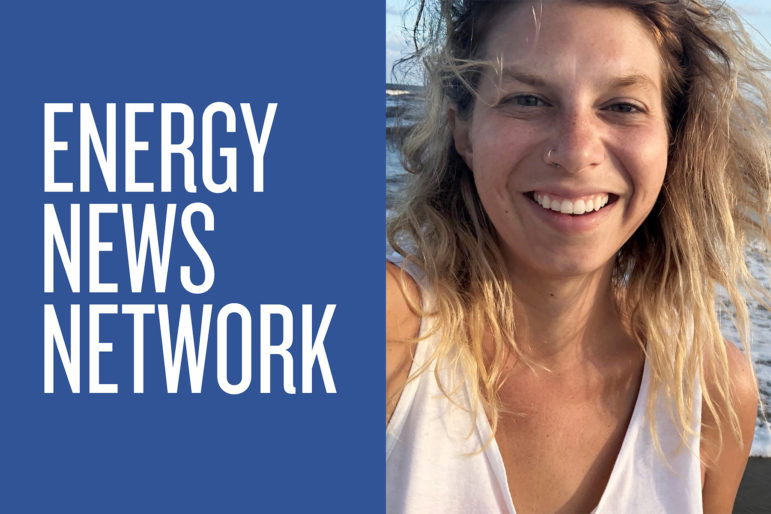
In our “behind the scenes” blog series, get to know our amazing team of dynamic journalists who make the Energy News Network possible. This month, we profile Lyndsey Gilpin who contributes her work from Louisville, Kentucky and is the publisher of her own weekly newsletter.
Tell us about your reporting background so far.
I earned my master’s degree at Medill School of Journalism at Northwestern University, where I focused on magazine writing and editing. After graduating, I worked for TechRepublic, a technology website owned by CBS Interactive, where I covered renewable energy and diversity in the technology industry. I soon left to go on a great Western road trip and landed in Los Angeles, where I freelanced for a few months before getting a fellowship at High Country News, a magazine about the American West. When my fellowship ended, I returned home to Louisville to start my freelance writing career in the South. I wanted to cover energy, climate change, and environmental justice in this region, which is sorely underrepresented and often stereotyped in mainstream media. My work has appeared in Harper’s, The Atlantic, The Guardian, Vice, InsideClimate News, CityLab, The Daily Beast, Scalawag, and more. I also publish a weekly newsletter—and soon to be publication! —called Southerly, which is about ecology, justice, and culture in the American South.
How did you get your start in journalism?
I decided I wanted to be a journalist when I was 11 years old. I wrote an essay that appeared in my local newspaper, The Courier Journal. When I saw my byline, I knew that I wanted to be a reporter and I’ve never considered any other career since. In college, I worked for the University of Louisville’s independent student newspaper. It was a scrappy paper, so I wore several different hats as the editor-in-chief.
Is Louisville, Kentucky your home town?
Yes, I’m from Louisville, Kentucky, home of the Kentucky Derby, the Louisville Slugger, Muhammad Ali, and of course, lots of bourbon. Some insider knowledge: locals pronounce it “Luh-vul.” It’s an amazing city—it’s not quite the Midwest, not quite the South, not in Appalachia, but it definitely has influences of all these regions.
You mentioned your experiences in different newsrooms. How do you feel about the future of the news business?
When I decided to become a journalist, people told me that it was too hard to get into—that no one wanted to pay for good journalism, no one respects it, the pay is terrible, and life would be too hard. I’d be lying if I told you life was easy as a journalist—it’s definitely not a life of luxury—and it’s clear that the rapid rise of online media and the decline of local news and newspapers has deeply impacted our society in ways we’re only just beginning to see. But right now, it feels like a really pivotal moment in history, and it seems like people are starting to understand the critical importance of good journalism—especially strong local journalism in our communities.
Why continue to do journalism in such a tough market?
It’s an incredible time to be a journalist. With the political divides in this country, the ongoing human rights injustices in every corner of the U.S., the effects of climate change rearing their heads, the upheaval of energy industries around the world, the regulatory capture of federal and state agencies, and the complicated nature of transitioning to a clean economy, there is no shortage of stories or things to investigate. There is also a resurgence of respect for journalism, and a hunger for solid, in-depth reporting that I’ve never seen before. The number of passionate reporters wanting to tell stories that have long been overlooked is inspiring. Knowing there are injustices to uncover and people who have stories to tell gets me out of bed every morning.
What’s the most difficult situation you’ve encountered as a reporter? How did you overcome it?
In 2016, I spent a year investigating sexual harassment in the National Park Service for High Country News. It was the most difficult, emotional, in-depth, rewarding series of stories I’ve ever worked on. I spent months building trust with women who experienced sexual harassment while working in our nation’s parks and monuments. I heard stories from more than 60 people about sexual assault, harassment, gender discrimination, and hostile work environments. Many of the people I interviewed didn’t feel comfortable going on the record, so I spent a lot of time listening and trying to learn more even if I knew I wouldn’t be able to use the information in my story. During that year, I also wrote dozens of Freedom of Information Act requests to the federal government, trying to track down information about sexual discrimination and harassment cases. The data about these cases was mostly nonexistent, and what I received was often incomplete It took hours of fact-checking to make sure everything in the piece was accurate. In the end, it culminated in a cover story for the magazine, and I was so happy with how it turned out—I felt like I did my sources justice and saw real impact from the year of dogged reporting.
Anything else people should know about you?
I stare at my computer all day, so yoga, hiking and my dog, Tule (who I found in Lindsay, California a couple years ago) keep me sane. Since I’ve become a freelancer and started working from home, we’ve been inseparable.
Read Energy News Network stories by Lyndsey Gilpin.
The Energy News Network is published by Fresh Energy, a non-partisan, nonprofit organization that advocates for clean energy policy. The Energy News Network is an editorially independent news and information site, and its contents should not be considered to reflect policy positions of Fresh Energy or our donors.
